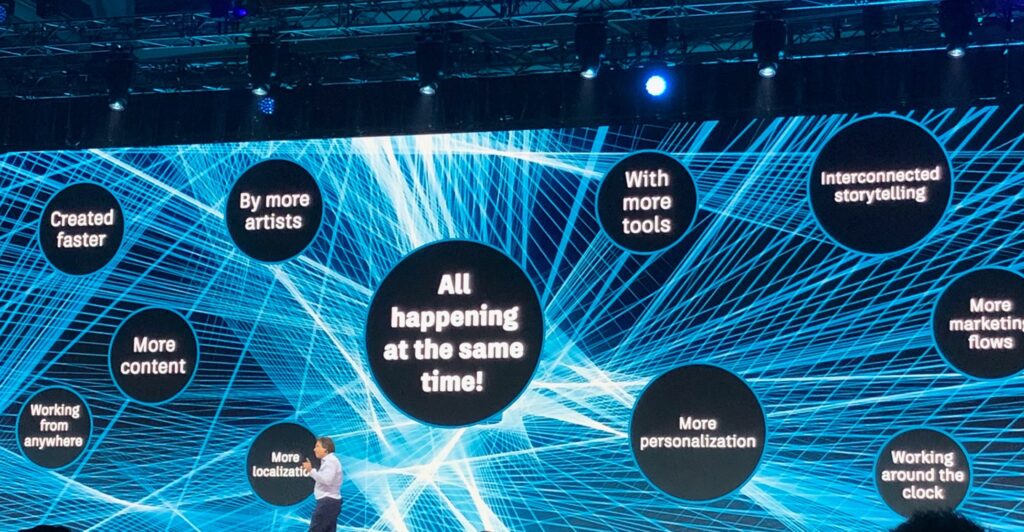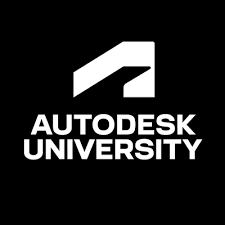Working on three industry clouds that will lead to a digital transformation in each segment.

Autodesk President and CEO Andrew Anagnost took the stage on the first day (September 28) of Autodesk University 2022 to a packed hall at the convention center in New Orleans, to a rousing rendition of “When the Saints Go Marching In” by musicians and dancers/entertainers in Mardi Gras style. It was a great way to excite the crowd and set a high note for the day as Anagnost welcomed the 10,000 attendees there in person and the approximately 25,000 watching remotely to the first live Autodesk University event in three years due to Covid.
In keeping with the theme of the host city and the conference (Autodesk’s core technology areas of AEC, BIM, manufacturing, and M&E), Anagnost introduced his first guest, Meagan Williams, who is a civil engineer/stormwater manager for the city of New Orleans, whose main job function is to oversee the impact of major weather events on the system. As she noted, living with water is a fact of life in New Orleans, whether dealing with hurricanes or rainfalls, as the water still has to be managed.
Williams was just 15 and living in New Orleans when Hurricane Katrina devastated the city. (Her commitment to the host city was met with a round of applause.) Serendipitously, her appearance as someone who needs to keep up with the latest engineering tools was especially poignant as Hurricane Ian was fast approaching Florida as a Category 4 storm to the east.
After Williams left the stage, Anagnost emphasized that we all have to be willing to change how we do things and acknowledge that the way we did things in the past might not be ideal for the way we do things in the future, to enable businesses to thrive and succeed. “The way we collaborate has changed—and changed forever. And the software needs to catch up,” he said. Some tools force users to do workflow manually, passing data back and forth. And oversharing, he notes, can get people in trouble—data gets lost in translation and needs to be patched over and over.
“It’s time for us to disrupt ourselves and pursue different ways of working,” added Anagnost.

Then the executive dropped the news. Autodesk is rethinking and refocusing their tools on a new paradigm, a new platform, that will exude efficiency. “We are progressing to building out the cloud,” he said.
Cloud production is not really new. There are tools out there that creatives use to do work in the cloud. However, the cloud workflow that Autodesk is envisioning, and working toward, is a digital transformative paradigm, a platform that connects workflows in the cloud for better outcomes and improved workflows.
“Our industries are embracing digital tools, but too often, people remain siloed in their respective jobs with disconnected processes, burdened by data that is not as useful as it could be,” Anagnost said. “The time is now for our customers to fully realize the benefits of digital transformation. Our Autodesk cloud capabilities will empower the innovators and creators we serve to be more productive and more profitable.”
A disruption is probably long overdue, Anagnost noted. “The industry cloud is different; it will help drive an entirely new way of working and bring a portfolio together in new ways to transform the way you work,” he added.

Autodesk cloud comprises the three Fs: Forma, the industry cloud for AEC, Flow for M&E, and Fusion for D&M (design & manufacturing). They each offer a set of common cloud services for their respective industry
- Forma unifies BIM workflows for teams that design, build, and operate the built environment. The first Forma offering will help users extend the BIM process into planning and early-stage design.
- Flow connects customer workflows, data, and teams across the entire production lifecycle from early concept to final delivery. The first cloud product available on Flow will be geared toward asset management, so users can manage assets throughout the entire production process.
- Fusion connects user data and people across the entire product development lifecycle. Fusion 360 (an integrated cloud CAD, CAM, CAE, and PCB software platform) along with Fusion 360 Manage product lifecycle management platform with Upchain and Prodsmart comprise the initial offering within Fusion. It is the most developed and mature of the three clouds.
Autodesk noted that as each industry cloud is built out, a central cloud information model will provide the right project collaborators with the right data at the right time on the device of their choice at every phase of a project. And that extends to data from other companies’ tools as well as those from Autodesk. “Teams need to be connected no matter what tools they use,” said Anagnost.
All three clouds are part of Autodesk Platform Services, Autodesk’s suite of Web APIs and services previously called Forge, which enable users to customize, extend, and connect Autodesk products with other solutions to create seamless end-to-end workflows. More functionalities will be built into the clouds over time, Anagnost said.
Why three clouds? To get the work done to make Autodesk cloud a reality because it is a challenging endeavor. Each group needs to engage with the people and their customer connections in order to move forward. If there were only one cloud platform, that process would have to be done by committee, and it would be difficult and would slow the progress significantly, explained Anagnost. That’s not to say that a single cloud solution is unattainable in the future; but for now, the first step is to get the three cloud solutions solidified and implemented. Even so, the work is many months—more like two years—out.
These industry clouds are the same application but hosted in different places. They automate workflows and provide valuable insights, Anagnost said, pointing to Fusion as an example of how transformative these tools will be.
But Autodesk is determined and committed to making this happen. However, it also requires buy-in from users who must be willing to change the way things have always been done. As Anagnost pointed out, during the pandemic, stand-alone tools could not meet the needs of those in manufacturing and design, in particular. Today, tools need to be fluid. “That is our vision for Fusion,” he said. “With project data unified in the cloud, you can omit grunt work and confusion.” In fact, the idea is for Fusion to span from the top floor to the shop floor, where all the information is pulled into the cloud platform so users should be able to stay digital entirely throughout a project.
Fusion has been developing for a decade, and that is why the Fusion cloud model is so far ahead of the other two. People are building natively on top of that model now.
In Forma, the first offering will be centered on design, and then sync with Revit, so data can be transferred between Revit and Forma, and then saved back to Forma. Initially, Forma will do upstream transformation but eventually will move downstream and across construction, transforming how everyone does BIM, said Anagnost.
More guests
After Anagnost delivered the industrial cloud news, he introduced more guests, who discussed some of the challenges they are facing today, and why tools of tomorrow are greatly needed.

BAS (British Antarctic Survey) is the UK’s polar research institute. David Brand is a senior product manager who is overseeing the construction of a single new 100-meter staff building in the Antarctic that will replace a series of older buildings. Working in such a harsh environment makes the project even more challenging. Collaboration is vital—as Brand notes, there are myriad logistical issues; it’s not like there is a hardware store around the corner if there is a miscommunication somewhere along the workflow requiring more supplies. Just getting supplies to the site is quit the feat. That is why there was a great deal of information sharing and early engagement among the partners, which continues.
Meanwhile, the M&E industry has its own share of challenges. The amount of data—hundreds of petabytes—that is produced and needs to be efficiently managed is astounding. Efficient asset management will enable creators to store and manage data, from modeling through to post-production. “We are working on that, whether it involves software from Autodesk or other vendors. As the line blurs between modeling and post, most people need to be involved earlier in the process, starting on set,” said Anagnost. This is when he made the pitch for Moxion, a camera-to-cloud solution Autodesk acquired early this year that makes data available in practically real time from on set starting when the director says “cut.”
Eric Iverson, head of product strategy at Amazon Studios, then took the stage to talk about the facility’s projects, including the current smash hit The Rings of Power, a production with over 10,000 visual effects shots. “To deliver stories such as these, we need to work harder,” he said. There are many great tools out there, he added, but with virtual production, all phases of production are happening at the same time, further increasing the complexity of producing a show. Said Iverson, the process is no longer linear.
As Iverson sees it, there are three tenets of a next-generation studio:
- It has to be socially responsible; people care about how Amazon Studios processes content and cares about inclusion and acceptability.
- It uses a globally connected cloud.
- It supports smart workflows that need to be able to evolve. Tools like ShotGrid for review and Moxion for creative reviews help streamline production handoff to post.
At Amazon Studios, there are a plethora of productions going on, with hundreds and hundreds of hours of uploaded content. To get through it all, the facility is committed to being a next-gen studio. But to do so, it needs tool vendors and creators to help them work towards that goal.

Anagnost sees remarkable parallels between M&E and manufacturing, where many departments are pushing data among teams, tools, and machines. Making all the data move fluidly is Autodesk’s vision for Fusion. A guest in this design & manufacturing segment was Betim Berisha, CEO and founder of BBI Autosport, which builds Porches from the ground up for racing and for the consumer market. In his experience, collaboration in the cloud was able to turn chaos into a manageable scenario, thanks to Fusion 360.
“We need all our partners to work together. Data management is important—the team needs to be on the same page all the time, partners too. The devil is in the details, and the details are in the data,” Berisha said.
And with that, the keynote address for Day 1 ended, with the message of the coming digital transformation looming large. Will you be ready when the time for change comes?






